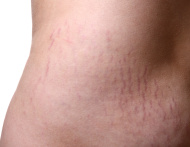Acne Scar | Age Spots | Anal Tag | Cellulite | Dropping Eyelids | Gynecomastia | Nail Fungus | Rosacea | Skin Lesion | Spider Veins | Stretch Marks | Tattoo | Wrinkle
 Stretch marks, or striae are a form of scarring on the skin with an off-color hue. They are caused by tearing of the dermis, and over time can diminish but not disappear completely.
Stretch marks, or striae are a form of scarring on the skin with an off-color hue. They are caused by tearing of the dermis, and over time can diminish but not disappear completely.
Stretch marks are often the result of the rapid stretching of the skin associated with rapid growth (common in puberty) or weight gain (e.g. pregnancy, muscle building, or rapid gain of fat) or in some cases, severe pulling force on skin that overcomes the dermis’ elasticity. Stretch marks may also be influenced by hormonal changes associated with puberty, pregnancy, muscle building, hormone replacement therapy for transsexuals, etc.
They first appear as reddish or purple lines, but tend to gradually fade to a lighter range. The affected areas appear empty and are soft to the touch. Stretch marks occur in the dermis, the resilient middle layer that helps the skin retain its shape. No stretch marks will form as long as there is support within the dermis. Stretching plays more of a role in where the marks occur and in what direction they run. Stretching alone is not the cause.
Stretch marks can appear anywhere on the body, but are most likely to appear in places where larger amounts of fat are stored. Most common places are the abdomen (especially near the navel), breasts, upper arms, underarms, back, thighs (both inner and outer), hips, and buttocks. They pose no health risk in and of themselves, and do not compromise the body’s ability to function normally and repair itself.
 Treatment
Treatment
Various treatments are available for the purpose of improving the appearance of existing stretch marks, including laser treatments, dermabrasion, and prescription retinoids. Some cream manufacturers claim the best results are achieved on recent stretch marks; however, few studies exist to support these claims.
A surgical procedure for removing lower abdominal stretch marks is the tummy tuck or mini tuck, which removes the skin below the navel where stretch marks frequently occur.
A new modality, fractional laser resurfacing, offers a novel approach to treating stretch marks. Using scattered pulses of light only a fraction of the scar is zapped by the laser over the course of several treatments. This creates microscopic wounds. The body responds to each treatment by producing new collagen and epithelium. The studies showed 5-6 fractional treatments improved both texture and appearance of striae and resulted in overall striae improving by as much as 75 percent.
Laser stretch mark removal is a procedure in which a laser is used to remove areas of the skin affected by stretch marks. Once the old, stretched skin is removed, new and unmarred skin grows to replace it. In most cases, a series of treatments is required to completely remove stretch marks. We perform a series of treatments and can get between 50 to 80% improvement in the appearance of these stretch marks. We can get great results with minimal downtime. The procedure is very safe with an extremely low incidence of side effects, all of which are temporary and minor.





